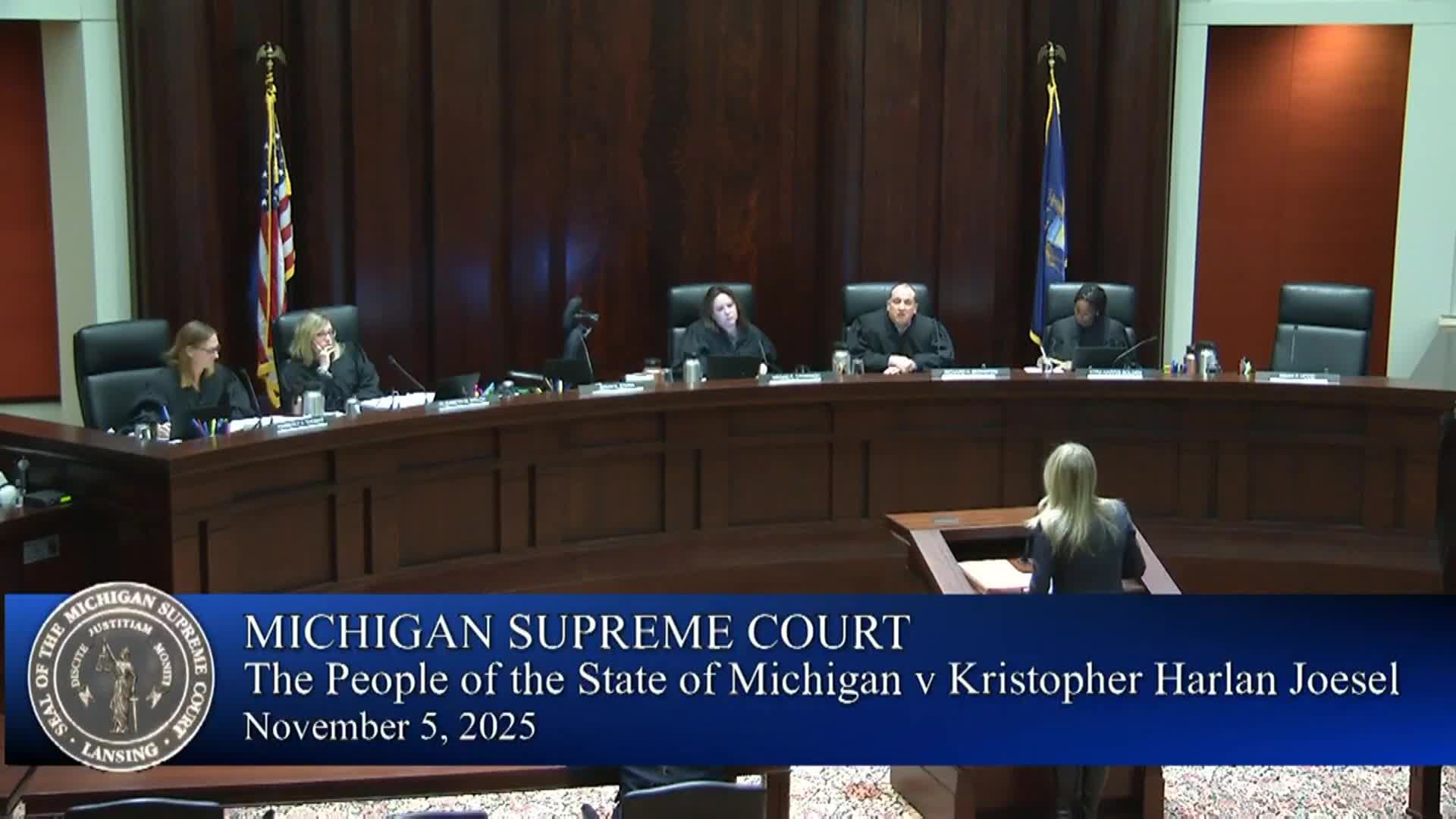Michigan Supreme Court hears arguments over manslaughter instruction in Joesel homicide appeal
November 06, 2025 | Supreme Court Judicial Rulings ( Opinions ), Judicial, Michigan
This article was created by AI summarizing key points discussed. AI makes mistakes, so for full details and context, please refer to the video of the full meeting. Please report any errors so we can fix them. Report an error »

The Michigan Supreme Court heard 15 minutes of argument over whether the trial court erred by refusing to give a manslaughter instruction based on heat of passion in People of the State of Michigan v. Christopher Joesel (case no. 167705). Appellant counsel Brett Cobb told the court that once evidence of provocation is admitted and a "rational view" of that evidence supports heat of passion, the manslaughter instruction "must be given." Cobb said the record showed the decedent twice chased the defendant, assaulted him — slamming him into a wall and causing a cut to his hand — and that the defendant was fearful, surprised and immediately reacted; a jury could reasonably find his passions were stoked.
Heather Blomquist, arguing for the People, said the video and the defendant's testimony instead showed a larger, stronger, armed defendant who stabbed the victim multiple times, then remained calm and in control. "The video . . . shows not a man acting out of passion, but a man who is acting with reason and control of his faculties," Blomquist said. She told the court that when the whole record is considered — including prior felonies, the defendant's conduct while leaving the scene, and the vestibule video — a rational view of the evidence did not support reducing the homicide to manslaughter.
Justices questioned counsel about the proper standard of review. Cobb distinguished two steps: a trial court's gatekeeping decision to exclude evidence (abuse of discretion) and the appellate question, posed after evidence is admitted, whether a rational view of the record supports the lesser-included instruction (he urged de novo review). Blomquist argued that trial-court factual findings relevant to whether an instruction was appropriate should receive abuse-of-discretion review and that recognizing automatic entitlement to a manslaughter instruction when evidence is admitted would "obliterate the gatekeeping function of the trial court."
The court also discussed harmless-error doctrine. Cobb argued it would be rare for an omitted manslaughter instruction to be harmless when the defendant's own testimony established elements of heat of passion. Blomquist pointed to an unusual feature of the trial proceedings: the jury received partial malice language that referenced manslaughter concepts, which she said made harmless-error analysis "very fact specific to this case." Counsel and justices discussed precedents cited by both sides, including Mayer (1862), Pouncey, Mendoza, Yeager, Roper, Oster and Veil, as examples courts have treated as adequate provocation in prior decisions.
Both sides acknowledged the fact-specific nature of adequacy-of-provocation inquiries: the court must consider the circumstances that led to the vestibule encounter, the role of any video evidence, and whether the defendant was the provoking party. Counsel and justices also debated the relationship between heat-of-passion analysis and the self-defense instruction that had been given to the jury; one justice asked how the court could reconcile giving self-defense while denying manslaughter. Blomquist replied that self-defense concerns the defendant's honest and reasonable belief of danger, while manslaughter requires both heat of passion and adequate provocation.
The argument concluded with counsel addressing related issues and the clerk noting the matter was submitted to the court.
Heather Blomquist, arguing for the People, said the video and the defendant's testimony instead showed a larger, stronger, armed defendant who stabbed the victim multiple times, then remained calm and in control. "The video . . . shows not a man acting out of passion, but a man who is acting with reason and control of his faculties," Blomquist said. She told the court that when the whole record is considered — including prior felonies, the defendant's conduct while leaving the scene, and the vestibule video — a rational view of the evidence did not support reducing the homicide to manslaughter.
Justices questioned counsel about the proper standard of review. Cobb distinguished two steps: a trial court's gatekeeping decision to exclude evidence (abuse of discretion) and the appellate question, posed after evidence is admitted, whether a rational view of the record supports the lesser-included instruction (he urged de novo review). Blomquist argued that trial-court factual findings relevant to whether an instruction was appropriate should receive abuse-of-discretion review and that recognizing automatic entitlement to a manslaughter instruction when evidence is admitted would "obliterate the gatekeeping function of the trial court."
The court also discussed harmless-error doctrine. Cobb argued it would be rare for an omitted manslaughter instruction to be harmless when the defendant's own testimony established elements of heat of passion. Blomquist pointed to an unusual feature of the trial proceedings: the jury received partial malice language that referenced manslaughter concepts, which she said made harmless-error analysis "very fact specific to this case." Counsel and justices discussed precedents cited by both sides, including Mayer (1862), Pouncey, Mendoza, Yeager, Roper, Oster and Veil, as examples courts have treated as adequate provocation in prior decisions.
Both sides acknowledged the fact-specific nature of adequacy-of-provocation inquiries: the court must consider the circumstances that led to the vestibule encounter, the role of any video evidence, and whether the defendant was the provoking party. Counsel and justices also debated the relationship between heat-of-passion analysis and the self-defense instruction that had been given to the jury; one justice asked how the court could reconcile giving self-defense while denying manslaughter. Blomquist replied that self-defense concerns the defendant's honest and reasonable belief of danger, while manslaughter requires both heat of passion and adequate provocation.
The argument concluded with counsel addressing related issues and the clerk noting the matter was submitted to the court.
View full meeting
This article is based on a recent meeting—watch the full video and explore the complete transcript for deeper insights into the discussion.
View full meeting
